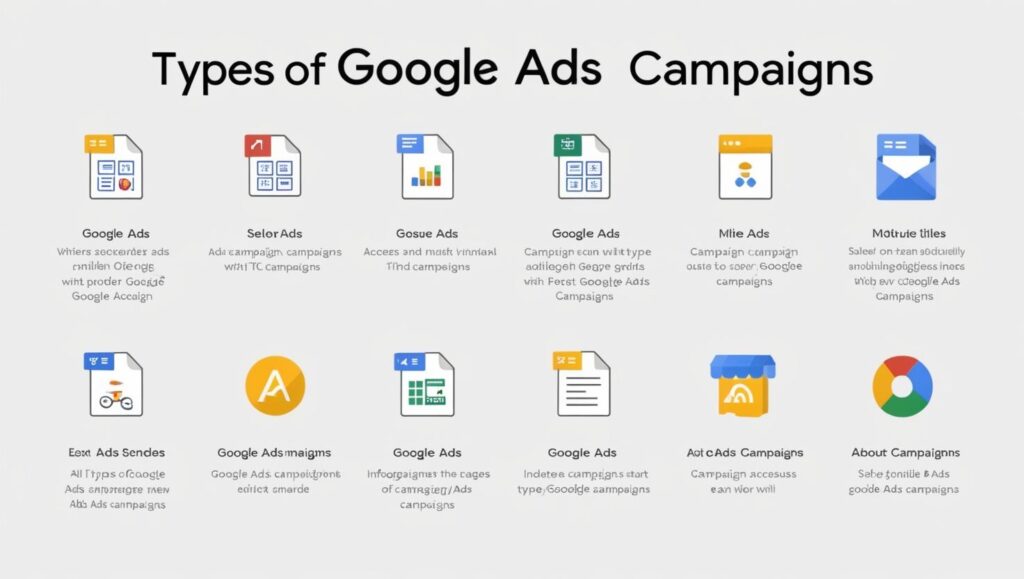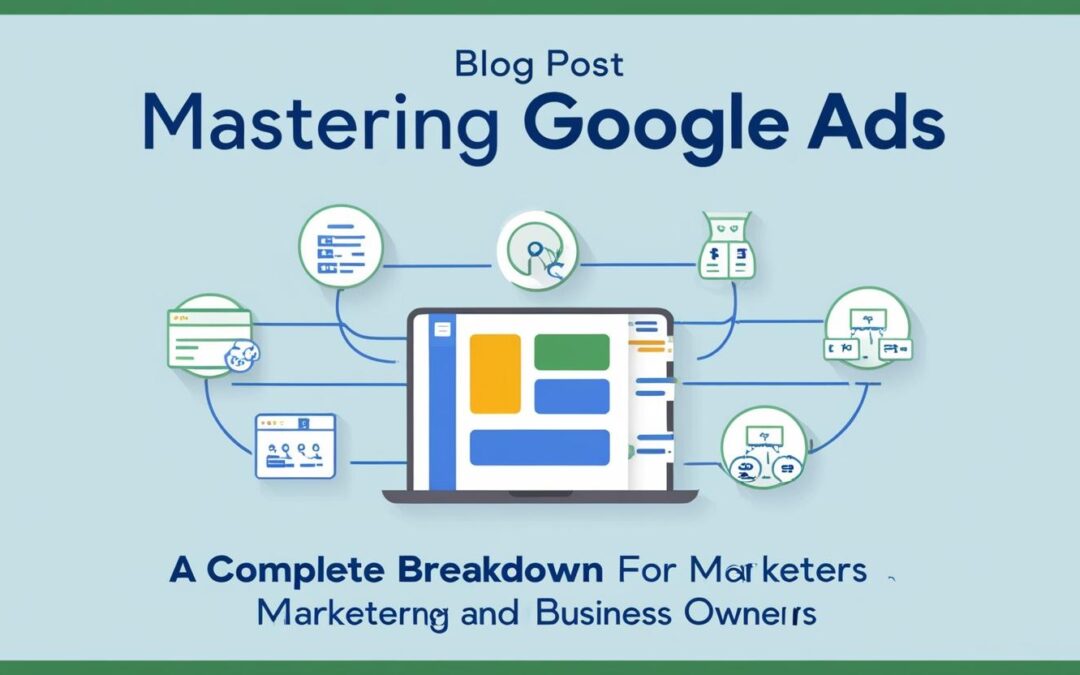1. Introduction
1.1 What Is Google Ads and Why Does It Matter?
Imagine you could place your business right in front of potential customers, the very moment they’re searching for exactly what you offer. Sounds powerful, right? Well, that’s what Google Ads lets you do. As one of the most influential digital marketing tools today, Google Ads allows businesses to run highly targeted ads across Google’s vast network. Whether you’re a small local business or a booming e-commerce store, Google Ads offers a powerful way to reach your target audience and drive relevant traffic that boosts sales.
In this guide, we’ll dive into everything you need to know to master Google Ads and leverage it for your business. Let’s get started!
2. What Is Google Ads?
2.1 Understanding Google Ads
At its core, Google Ads is a pay-per-click (PPC) advertising platform. This means businesses bid on keywords that are relevant to their products or services. Whenever someone searches for these keywords, Google ranks the ads based on a combination of the bid amount, the ad’s relevance, and the quality of your landing page. And here’s the kicker: you only pay when someone clicks on your ad!
The Google Ads system is like an auction, but it’s not just about how much you bid. It’s also about creating ads that are relevant and valuable to users. The more aligned your ad is with what people are searching for, the higher it’ll rank.
2.2 Where Do Google Ads Appear?
Google Ads appear in several places across Google’s vast network:
- Google Search Results: Text-based ads show up at the top or bottom of Google search results. These ads target users who are actively looking for specific products or services.
- Google Display Network (GDN): Banner ads can appear across millions of websites, reaching users based on their interests, demographics, or behavior.
- YouTube Ads: These ads appear before, during, or after videos. Perfect for those who want to engage users through video content.
- Google Shopping Ads: E-commerce businesses can use these to showcase product images, prices, and details directly in search results.
- Google Discover & Gmail Ads: Personalized ads that show up in Google’s Discover feed or Gmail’s Promotions tab, targeting users as they browse through content or check their email.
- Google Maps Ads: When users search for businesses nearby, your ad could appear with your business details.
- Google Play Store Ads: These ads promote apps, making them ideal for businesses aiming to increase app downloads.
- Google Assistant Ads: As voice search grows, businesses can also appear in voice-activated search results on Google Assistant.
3. Why Use Google Ads?
3.1 Benefits of Google Ads for Businesses
Google Ads is packed with benefits that can help businesses grow:
- Instant Visibility: Get your business on the first page of Google results within hours. This is perfect for time-sensitive promotions or events.
- Targeted Audience Reach: Google Ads allows you to target your audience based on their search intent, demographics, location, and past behavior, ensuring you reach the right people at the right time.
- Flexible Budget Control: You have complete control over how much you spend. Set a daily budget, and adjust campaigns at any time to fit your business needs.
- Performance Tracking: Google Ads offers in-depth analytics, letting you track how well your ads are performing and adjust accordingly for better results.
- Competitive Edge: By outranking competitors, you can capture more market share, expand your reach, and boost brand visibility.
3.2 Google Ads vs. SEO vs. Social Media Ads
- Google Ads vs. SEO: Google Ads offers immediate results—your ad can be visible within hours. In contrast, SEO is a long-term strategy, requiring more effort and time to build organic rankings, but with long-lasting results.
- Google Ads vs. Social Media Ads: Google Ads are search-based, targeting users actively searching for your products, whereas social media ads are interest-based, showing ads to users based on their behavior and interests.
3.3 Is Google Ads Necessary for Every Business?
While Google Ads is a powerful tool, it’s not right for every business. Here’s when it’s ideal—and when it might not be:
- Ideal for:
- Local Businesses: Perfect for businesses targeting local customers, such as restaurants or home services.
- E-commerce Stores: Google Shopping Ads help showcase products directly in search results.
- Service Providers: Whether you’re in healthcare or home repair, Google Ads allows you to target people actively searching for services.
- Not Ideal for:
- Niche Markets with Low Demand: If you’re in a specialized industry with little search volume, other methods, like influencer marketing, might be more effective.
- Long-Term Brand Building: If you’re focusing more on SEO or content marketing for long-term growth, Google Ads might not be the best strategy.
4. Types of Google Ads Campaigns

4.1 Search Ads
These are text-based ads that appear when someone searches for a keyword you’ve bid on. The key to success here is crafting clear, compelling ad copy with a strong call-to-action (CTA).
4.2 Display Ads
These ads are visuals that appear on websites across the Google Display Network. Display ads are great for brand awareness, as they reach a broader audience beyond just people searching for your product.
4.3 Shopping Ads
If you run an e-commerce store, shopping ads are essential. These ads display your products directly in Google search results, complete with images, prices, and details, helping to boost conversions.
4.4 Video Ads (YouTube Ads)
YouTube ads can be skippable, non-skippable, or bumper ads. They are perfect for engaging potential customers through video, making it easier to explain or demonstrate your product.
4.5 App Promotion Ads
For businesses with apps, app promotion ads are invaluable. They help drive app downloads or increase engagement within your app.
4.6 Performance Max Campaigns
These AI-powered campaigns optimize across all Google platforms, ensuring your ads reach the right audience on YouTube, search, Gmail, and beyond—all from one campaign.
5. How to Tell If a Competitor Is Using Google Ads
5.1 Identifying Paid Search Ads
When browsing Google, you can easily spot competitor ads—they’ll have the “Ad” or “Sponsored” label next to the website link.
5.2 Finding Google Display and Video Ads
Check websites or YouTube for ads that look familiar or relevant to your industry. Banner ads or video ads often belong to your competitors.
5.3 Using Competitor Analysis Tools
Tools like SEMrush, SpyFu, and Google Ads Transparency Center let you see which keywords competitors are bidding on and how their ads are performing.
6. How Google Ads Works: The Mechanics
6.1 Google Ads Auction and Bidding System
When you set up a Google Ads campaign, you’re entering an auction. But it’s not just about who bids the highest; it’s also about the relevance and quality of your ad.
6.2 Quality Score and Ad Rank
Google assigns each ad a Quality Score, factoring in the relevance of your keywords, ad copy, and landing page experience. Combined with your bid, this determines where your ad will appear on the search results page.
6.3 Targeting Options in Google Ads
Google Ads offers plenty of targeting options, from keyword targeting to audience targeting, remarketing, and location-based targeting—allowing you to fine-tune your reach.
7. Measuring Google Ads Performance: Key Metrics
7.1 Click-Through Rate (CTR) and Impressions
CTR shows how many people clicked your ad after seeing it, while impressions tell you how often your ad was displayed. High CTR means your ad is relevant and compelling.
7.2 Cost Metrics: CPC, CPA, and ROAS
CPC (Cost-Per-Click), CPA (Cost-Per-Acquisition), and ROAS (Return on Ad Spend) help you measure how cost-effective your campaigns are.
7.3 Conversion Tracking
Setting up conversion tracking lets you track the actions users take, such as purchases or sign-ups. This helps you understand whether your campaigns are truly driving results.
7.4 Ad Position and Auction Insights
Google Ads provides data on where your ads are showing up and how you compare to competitors. These insights can help you optimize your campaigns for better performance.
8. Common Mistakes to Avoid in Google Ads

8.1 Poor Keyword Selection
Targeting irrelevant or overly broad keywords wastes money. Be strategic with your keyword selection to ensure you’re attracting high-intent users.
8.2 Wasting Budget on the Wrong Audience
Use audience segmentation to target the right people. Whether it’s based on demographics or behavior, reaching the right audience is crucial for maximizing ROI.
8.3 Ignoring Negative Keywords
Negative keywords prevent your ads from showing up for irrelevant searches, saving you money on clicks that won’t lead to sales.
8.4 Weak Ad Copy and Low Conversion Landing Pages
Your ad copy should be clear, enticing, and include a strong CTA. Also, ensure your landing page aligns with your ad and provides a seamless experience to increase conversions.
9. Best Practices for a Successful Google Ads Campaign
9.1 Setting Up a Winning Campaign Strategy
Start with clear goals, choose the right campaign types, and ensure your ads match the buyer’s journey. Set a realistic budget and adjust as needed.
9.2 Writing High-Converting Ad Copy
Create multiple versions of your ad copy, testing for what resonates best with your audience. Strong headlines and clear CTAs are key.
9.3 Optimizing Budget and Bidding
Leverage smart bidding strategies like Target CPA or Target ROAS to optimize your budget and maximize results.
9.4 Using Remarketing for Better Conversions
Remarketing allows you to target users who’ve already interacted with your business. These users are more likely to convert, making remarketing a powerful tool.
10. The Future of Google Ads: What’s Next?
10.1 AI and Automation in Google Ads
AI is transforming Google Ads by automating optimizations and bid adjustments, ensuring campaigns run more efficiently.
10.2 The Impact of Privacy and Cookie Changes
With privacy laws evolving and third-party cookies fading, first-party data will become more crucial for targeting. Marketers must adapt to maintain effective campaigns.
10.3 The Rise of Video and Interactive Ads
Video ads are increasingly popular for their engaging, interactive nature. Expect these formats to dominate Google Ads in the future.
Conclusion: Making the Most of Google Ads
Google Ads is an incredibly powerful tool that can take your business to the next level. By mastering its features—setting the right campaigns, tracking performance, and avoiding common mistakes—you can drive traffic, increase conversions, and grow your brand. With Google Ads, the possibilities are endless. So go ahead, start optimizing your campaigns today, and watch your business thrive in the digital landscape.

